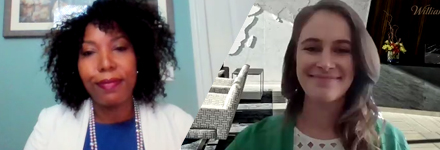
William Blair’s Women’s Alliance partnered with the Chicago Financial Women’s Alliance (CFWA) to host its first in a series of 2021 career talks, featuring female professionals in the financial services industry.
William Blair Equity Research analyst Maggie Nolan was one of the moderators for the virtual event held April 15, and Alaina Anderson, a portfolio manager with Investment Management, was among the guest panelists.
The Women’s Alliance joined BMO Harris, BNY Mellon, DWS, and Morningstar as a member of the Chicago Financial Women’s Alliance in 2019.
“We were initially drawn to the CFWA’s mission to build a pipeline of strong female financial services leaders and the opportunity to increase our external networking and branding,” said Beth Pekol Porto, a co-chair of WB’s Women’s Alliance and a SA editor with the Equity Research team. “But we quickly learned that the CFWA provides much more, including events like the new career series we are offering William Blair colleagues to attend.”
Being comfortable with being uncomfortable
During the event, Anderson shared how her career has developed over the years, beginning in the financial services industry two decades ago. Before joining William Blair in 2006 as a small-cap analyst on the global team in IM, she was an analyst in the investments office of the MacArthur Foundation, an investor relations consultant with Ashton Partners, and a financial advisor with UBS. Anderson, a partner of the firm, earned her MBA from the University of Chicago Booth School of Business and has her CFA designation.
“My career has been colored by dealing with discomfort,” Anderson told the gathering. “I am probably more comfortable with being uncomfortable than most.”
Early in her career, Anderson was often the only person of color, sometimes the only woman, sometimes the youngest person in the room. Anderson says she leaned into that discomfort by being poised, prepared, and outgoing.
But at some point she became aware of others’ discomfort with her. For a while Anderson tried managing it by changing the tone of her voice in meetings, changing the color or texture of her hair, or acting more reserved.
“Luckily, that phase is over,” Anderson says. “Rather than managing discomfort, I lean into it. That allows me to let uncomfortable silence work for me, asking that question when no one is willing to, or having a tough conversation.”
On mentors
Anderson also recommended having a stable of mentors, both informal and formal, men and women.
“There are a lot of people out there who are willing to lend a hand and happy to talk,” she said.
One way she has developed informal mentors is reaching out to people she admires—buys them a cup of coffee and just listens to their stories. Anderson values learning from others who work in the global financial services industry, especially seasoned professionals with insights on how they managed the peaks and valleys of their careers.
Many times Anderson has been asked by those she mentors whether they should pursue an advanced degree or additional licenses to advance their careers.
Her advice: It helps.
No doubt women and people of color face bias and getting that degree or earning a security license or CFA doesn’t guarantee you will get the job you want, she says. But Anderson advises that pushing yourself to earn that degree or certification makes it more difficult for someone to say “no” to you when looking for that next position.
“How do you make ‘no’ difficult? You check all the boxes,” Anderson adds. “I certainly wasn’t excited about spending three years of my life missing Memorial Day to get the CFA. It was about making ‘no’ very difficult for someone on the other side of the table to say.”
Do the job you want
Similarly, she recommended to start doing the job you want.
From the onset of her career, Anderson wanted to be a portfolio manager. So she put together a paper portfolio that centered around the work she was doing as an analyst. She figured out how to do a pitch deck. She figured out how to trade the portfolio through operations and watched the performance. She also talked to a couple endowments and foundations, asking what they thought about the product she created.
“Again, it is kind of hard to say ‘no’ to me when that opportunity comes up because I have already shown I can do it.”


